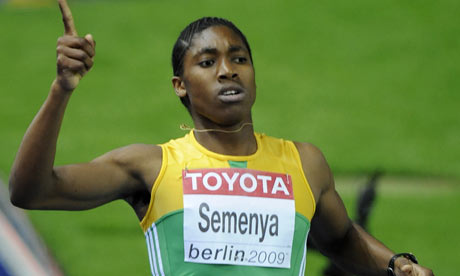Recently, middle-distance runner Caster Semenya accused the International Association of Athletics Federations’ rules regarding testosterone suppression for female athletes as discriminatory. In response, a ruling was made by South Africa’s Court of Arbitration for Sport stating that Semenya must suppress her testosterone levels in order to compete in women’s track and field events.
The following was originally published in the August 2009 issue of Blue Ridge Outdoors Magazine.
Caster Semenya, an 18-year-old from South Africa, won the world championships in the 800 meters last week in Berlin. Her time of 1:55.45 was the fifth fastest in world history. Even more impressive is her rags-to-riches story: up until recently, she was an unknown runner from a small, impoverished desert village. For most of her young life, she ran on an uneven dirt track and fetched water from a community borehole.
All that changed three weeks ago when she won the 800 meters at the African Junior Championships. Following her victory, the International Association of Athletics Federations (IAAF) requested a “gender test” on Semenya, raising questions over whether she was indeed a female.
Even if the test is warranted, the decision to publicize the controversy is tragic for the Semenya, who has been so overwhelmed by the media frenzy that she nearly declined to accept her gold medal at the world championships last week. At the very least, the IAAF could have quietly requested a “gender test,” rather than igniting a global firestorm by leaking it to the media. Their lack of tact and discretion will likely scar a young woman for life.
Most people assume that gender is a binary issue, when in fact it has many shades of gray. Sex is more of a continuum than most of us realize, and the development of genitalia for either gender can be delayed by several chromosomal abnormalities.
Biologically speaking, the Y chromosome is the typical indication for male (XY), and its absence (XX) is an indication of female. But even that distinction is blurred by intersex individuals and chromosomal abnormalities that may not express themselves until after puberty or later in life. The IAAF recognized that chromosome testing alone is inconclusive, which is why they expanded the “gender test” in 1996 to include a case-by-case analysis that brings together a gynecologist, endocrinologist, psychologist, an internal medicine specialist, and gender expert. In the case of Semenya, their goal is to determine whether her biology—wherever she falls on the sex continuum—gave her an unfair advantage over her opponents.
Athletics is fraught with men masquerading as women. Ironically, in the same Berlin stadium where Semenya won her world championship last week, a young Nazi male named Herman Ratjen bound up his genitals, called himself “Dora,” and entered the 1936 Olympics, where he placed fourth in the high jump. Three women still beat the masquerading male…so much for Nazi superiority.
But in this case, it appears that Semenya was not attempting to hide her gender or masquerade as anyone other than herself. This talented, hard-working, world champion runner has been utterly humiliated by officials and the press. The media orgy will likely climax with the conclusion of the “gender test, ” but this nightmare will haunt Semenya for the rest of her life.








